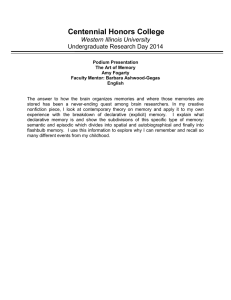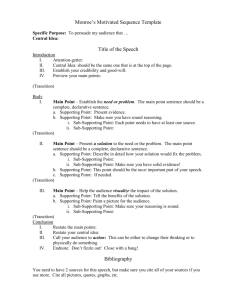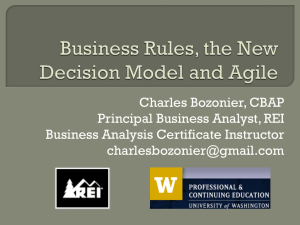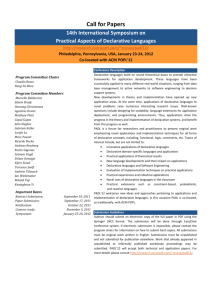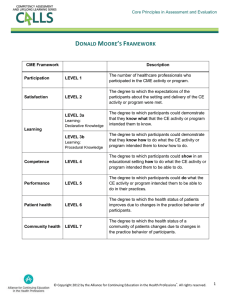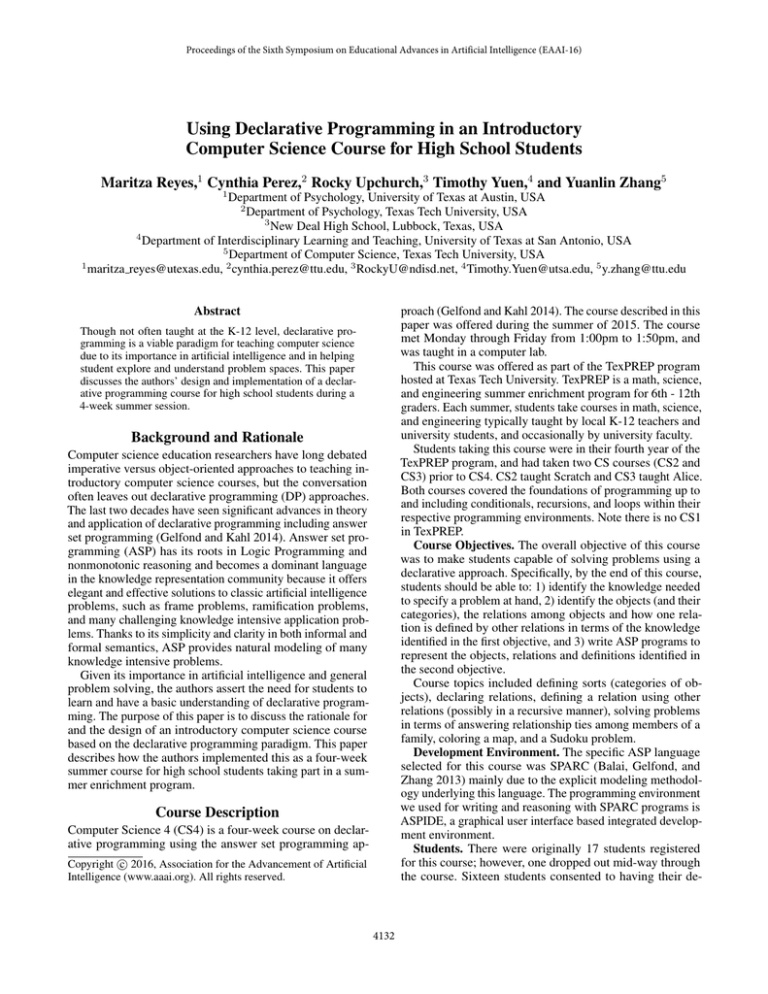
Proceedings of the Sixth Symposium on Educational Advances in Artificial Intelligence (EAAI-16)
Using Declarative Programming in an Introductory
Computer Science Course for High School Students
Maritza Reyes,1 Cynthia Perez,2 Rocky Upchurch,3 Timothy Yuen,4 and Yuanlin Zhang5
1
Department of Psychology, University of Texas at Austin, USA
2
Department of Psychology, Texas Tech University, USA
3
New Deal High School, Lubbock, Texas, USA
4
Department of Interdisciplinary Learning and Teaching, University of Texas at San Antonio, USA
5
Department of Computer Science, Texas Tech University, USA
1
maritza reyes@utexas.edu, 2 cynthia.perez@ttu.edu, 3 RockyU@ndisd.net, 4 Timothy.Yuen@utsa.edu, 5 y.zhang@ttu.edu
proach (Gelfond and Kahl 2014). The course described in this
paper was offered during the summer of 2015. The course
met Monday through Friday from 1:00pm to 1:50pm, and
was taught in a computer lab.
This course was offered as part of the TexPREP program
hosted at Texas Tech University. TexPREP is a math, science,
and engineering summer enrichment program for 6th - 12th
graders. Each summer, students take courses in math, science,
and engineering typically taught by local K-12 teachers and
university students, and occasionally by university faculty.
Students taking this course were in their fourth year of the
TexPREP program, and had taken two CS courses (CS2 and
CS3) prior to CS4. CS2 taught Scratch and CS3 taught Alice.
Both courses covered the foundations of programming up to
and including conditionals, recursions, and loops within their
respective programming environments. Note there is no CS1
in TexPREP.
Course Objectives. The overall objective of this course
was to make students capable of solving problems using a
declarative approach. Specifically, by the end of this course,
students should be able to: 1) identify the knowledge needed
to specify a problem at hand, 2) identify the objects (and their
categories), the relations among objects and how one relation is defined by other relations in terms of the knowledge
identified in the first objective, and 3) write ASP programs to
represent the objects, relations and definitions identified in
the second objective.
Course topics included defining sorts (categories of objects), declaring relations, defining a relation using other
relations (possibly in a recursive manner), solving problems
in terms of answering relationship ties among members of a
family, coloring a map, and a Sudoku problem.
Development Environment. The specific ASP language
selected for this course was SPARC (Balai, Gelfond, and
Zhang 2013) mainly due to the explicit modeling methodology underlying this language. The programming environment
we used for writing and reasoning with SPARC programs is
ASPIDE, a graphical user interface based integrated development environment.
Students. There were originally 17 students registered
for this course; however, one dropped out mid-way through
the course. Sixteen students consented to having their de-
Abstract
Though not often taught at the K-12 level, declarative programming is a viable paradigm for teaching computer science
due to its importance in artificial intelligence and in helping
student explore and understand problem spaces. This paper
discusses the authors’ design and implementation of a declarative programming course for high school students during a
4-week summer session.
Background and Rationale
Computer science education researchers have long debated
imperative versus object-oriented approaches to teaching introductory computer science courses, but the conversation
often leaves out declarative programming (DP) approaches.
The last two decades have seen significant advances in theory
and application of declarative programming including answer
set programming (Gelfond and Kahl 2014). Answer set programming (ASP) has its roots in Logic Programming and
nonmonotonic reasoning and becomes a dominant language
in the knowledge representation community because it offers
elegant and effective solutions to classic artificial intelligence
problems, such as frame problems, ramification problems,
and many challenging knowledge intensive application problems. Thanks to its simplicity and clarity in both informal and
formal semantics, ASP provides natural modeling of many
knowledge intensive problems.
Given its importance in artificial intelligence and general
problem solving, the authors assert the need for students to
learn and have a basic understanding of declarative programming. The purpose of this paper is to discuss the rationale for
and the design of an introductory computer science course
based on the declarative programming paradigm. This paper
describes how the authors implemented this as a four-week
summer course for high school students taking part in a summer enrichment program.
Course Description
Computer Science 4 (CS4) is a four-week course on declarative programming using the answer set programming apc 2016, Association for the Advancement of Artificial
Copyright Intelligence (www.aaai.org). All rights reserved.
4132
mographic information and coursework released as part of
a larger study. Of these students, there were 9 males and 7
females. The average age was 15. Most students were in 10th
grade (11 students) with three 11th graders, and two 12th
graders.
Instructional Staff. The course was taught by the last coauthor, a computer science professor at the hosting university,
along with three teaching assistants (the first three co-authors)
who were given a one week training on ASP. The assistants
would help with any questions or concerns that the students
had.
Course Activities. The activities of the course mainly included lecture and assignments. Each week consisted of four
lectures and one lab assignment, which was based off of the
topics and activities done during the lectures. Lecture notes
were provided to the students so they could follow along with
the lecture. In the lecture, the instructor introduced the main
concept, shows examples and asks students to apply what
was learned to new examples, and demonstrate the programs.
Then, students will implement the same example programs
on their own on computers. Assignments dealt with stating
factual relations, recursive definition of relations, and solving
map coloring, and Sudoku problems.
Labs. There were three graded lab problems through
which course topics and activities centered on. Family Problem: Students were asked to identify interesting queries about
relationships (e.g., mother, mom, ancestor) of a family, create
specific information about a family, and write a SPARC program based on which the identified queries can be answered
automatically by the SPARC system. Map Coloring Problem:
Given a map of US states, the students were asked to write a
SPARC program to answer whether this map can be colored
with red, green or blue such that no neighboring states are
allowed to have the same color. Sudoku Problem: This problem is based on the well known number logic game. Students
were asked to write a SPARC program which found all the
missing numbers in a Sudoku problem.
programming with the SPARC language. This preliminary
finding suggests that novice CS students are able to operate
within the declarative programming paradigm.
Interest. According to course evaluations, most students
have enjoyed this course. In order to evaluate how CS4 impacted students’ interest in CS careers, the authors administered the STEM Career Interest Survey (Kier et al. 2014).
This survey was adapted for this course by focusing all 11 survey questions in computer science. Participants were asked
to rate their level of agreement between 1-Strongly Disagree
to 5-Strong Agree with each statement related to interest
in CS. The average overall pre-test score was 3.62 and the
average overall post-test score was 3.52. Though there was
moderate interest in pursuing CS as a career, there was a
slight decline after the course. These survey results could
be due to the fact that this course was the third CS course
these students have taken. Therefore, their interests in CS
would have stabilized by this time. Another reason could be
that four weeks was insufficient time to spark further interest in declarative programming. Further, as indicated by an
open-ended questionnaire on their career interests, the group
of participants had a diverse set of career aspirations and
reported some issues with the way the course was organized,
which may account for the decrease. Further iterations of this
course may draw in more relevant examples that are relevant
to both students’ everyday lives and interests.
Discussion and Conclusions
The authors believe that the declarative programming
paradigm is as important as imperative and object-oriented
approaches to computer science. A precise specification and
understanding of a problem is critical in problem solving
and lays in the core of computer science. Declarative programming emphasizes problem specification instead of how a
problem is solved, and offers a natural and simple representation for the specification of numerous problems. It allows the
students to work on more interesting and challenging problems such as Sudoku problem in their early stage of learning
programming. Programming becomes a formalization of the
”familiar” thinking (in terms of specification and understanding of problem) that people need when solving intellectually
interesting problems.
Evaluation and Feedback
To examine the impacts of declarative programming on computer science learning more rigorously, the authors are currently analyzing data from artifacts, surveys, and interviews
collected from students taking this course in Summer 2015.
This upcoming study will show how the declarative programming paradigm guides students in computational thinking,
problem solving, and interests in computer science. Preliminary results with regards to achievement and interests in this
CS course are presented here.
Learning. Students had performed well in the lab assignments and in class. Each lab was graded by two graders, and
the average class score on the three graded labs were: Lab
2: 93.2%, Lab 3: 92.2%, and Lab 4: 93.2%. These averages
only include grades for labs that were submitted on time.
Students were given an open-ended questionnaire at the
end of the course. One question asked students to summarize
what they learned. The students reported that they were able
to solve problems using the methodologies and tools of the
declarative programming paradigm. Students also reported
that they learned specifically how to solve problems through
Acknowledgment
We thank Michael Gelfond for sharing with us his teaching
materials and philosophy. This work is partially supported by
NSF grant IIS-1018031 and CNS-1359359.
References
Balai, E.; Gelfond, M.; and Zhang, Y. 2013. Towards answer
set programming with sorts. In Logic Programming and Nonmonotonic Reasoning. Springer. 135–147.
Gelfond, M., and Kahl, Y. 2014. Knowledge representation,
reasoning, and the design of intelligent agents: The answer-set
programming approach. Cambridge University Press.
Kier, M. W.; Blanchard, M. R.; Osborne, J. W.; and Albert, J. L.
2014. The development of the stem career interest survey (stemcis). Research in Science Education 44(3):461–481.
4133

